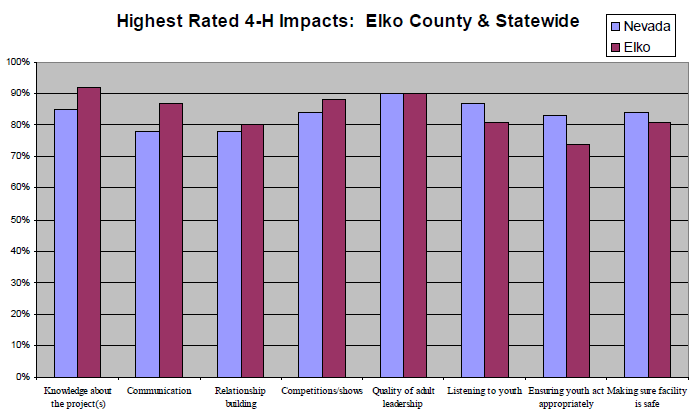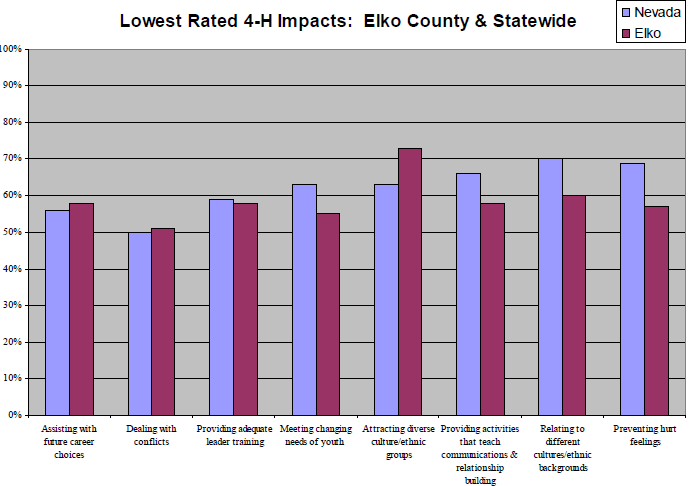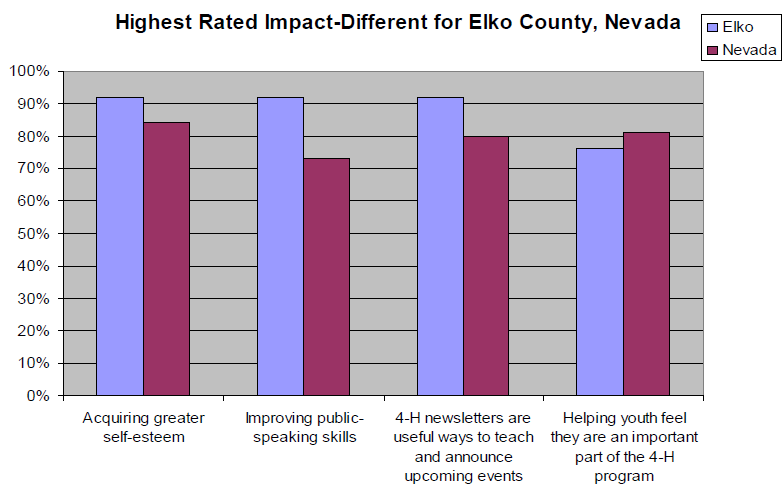Introduction
In continued efforts to assess 4-H program impacts, in 2003, University of Nevada Cooperative Extension surveyed all 4-H parents and leaders statewide. The results were sorted by county. Understanding impacts at the county level is important because 4-H programs in Nevada are managed at the county level. This fact sheet reports the impact assessment results statewide, highlighting Elko County. The purpose of this report is to inform 4-H parents, leaders, and youth members how 4-H impacts their lives, and also assist 4-H professionals to develop an action plan to further strengthen Elko County 4-H.
Designing and Conducting the Assessment
In designing a survey to assess 4-H program impacts, two models for youth development were used. The first model is based upon six outcomes associated with successful youth development: confidence, competence, caring, connection, contributing, and character (Blyth, 2000).
In designing a survey to assess 4-H program impacts, two models for youth development were successful youth development helps children become: confident they can make a difference; competent through their ability, skills, and knowledge, and; able to work with people in a way that develops and promotes caring relationships. These youth connect beneficially with people and In designing a survey to assess 4-H program impacts, two models for youth development wereuccessful youth organizations, contribute their services to make a difference in their personal development as well as in their community, and demonstrate responsible and honest character, or a sense of who they are.
In designing a survey to assess 4-H program impacts, two models for youth. The second model used to develop the assessment questions focuses on “core concepts” and provides a basis for successful youth development programs in Nevada (UNCE, 1993). Such programs produce youth who:
- learn and practice self-responsibility and social responsibility to feel accountable and in control of their lives;
- recognize when and how to make informed decisions and implement decisions to solve a problem or achieve goals;
- communicate effectively in both verbal and written form, to share thoughts and feelings that increase social competence, and;
- obtain career and occupational information to help prepare for the world of work.
Questions developed for this assessment were based upon the six desired outcomes of positive youth development and Nevada’s “core concepts” for teaching life skills. Combining models resulted in nine questions to assess the effectiveness of 4-H in teaching youth life skills and six questions to assess the social skills that youth learn; six questions to measure the effectiveness of traditional 4-H teaching tools, and; four questions to assess the effectiveness of program management goals.
In addition, eighteen questions were developed specifically to assess skills of parents and volunteer leaders to teach youth, manage 4-H programs, and prevent negative and high-risk behavior among 4-H youth. These questions were based on skills established by the National Committee on Community Programs to Promote Youth Development (Eccles and Gootman, 2002), and were designed to assess the indirect impacts of Nevada 4-H on parents and volunteer leaders.
Participants in the assessment included all parents and adult volunteer 4-H leaders currently enrolled in Elko County. These participants were selected based on the rationale that 4-H leaders and parents of 4-Hers have the most frequent opportunity to observe any changes that occur among youth participating in 4-H programs.
Each individual was mailed a two-page questionnaire with instructions and a self addressed/ postage paid, return envelope. Also included was a cover letter that explained the purpose of the survey, ensured confidentiality to participants, and thanked them for their participation. Of the 276 survey recipients, 85 returned completed questionnaires, resulting in a 31 percent response rate.
Statewide and County Impacts
On a scale of 1 to 5, with “1” being “very low” and “5” being “very high,” respondents were asked to circle the number that best indicates how effectively 4-H is developing youth and impacting adults involved. The results are presented by highest and lowest ratings. Results for Elko County are presented alongside statewide results for comparison purposes.
The highest rated impacts are illustrated in Figure 1. The abbreviated questions are listed below each bar graph to specify and illustrate the percentage responses for each question.
According to the assessment results, the top life skill Elko County youth learn is acquiring greater self-esteem and (tied with) knowledge about the project(s). The highest rated social skill youth learn is improved public-speaking. In terms of 4-H teaching and program management goals, the highest rated impacts in Elko County are: 4-H newsletters are useful ways to teach and announce upcoming events and quality of adult leadership skills is key to achieving a successful 4-H program. For 4-H parents and volunteer leaders, the highest rated parent and leader teaching skill is listening to youth; the highest ranked program management skill is helping youth to feel they are an important part of the 4-H program; and the highest ranked prevention skill is making sure the facility where we have 4-H is safe.
Figure 1

Data From Figure 1
Figure 2 illustrates areas to target for improvement in Elko County 4-H. Results indicate the lowest rated life skill Elko County youth learn is learning about future career choices. The lowest rated social skill youth learn is dealing with conflicts.
In terms of 4-H teaching and program management goals, the lowest rated impacts in Elko County are volunteer leader training is adequate in providing the skills needed to lead projects and 4-H meets the changing needs of youth. For 4-H parents and volunteer leaders, the lowest rated parent and leader teaching skill is provides activities to help youth learn social skills such as communication and relationship building; the lowest rated program management skill is relating well to youth from different cultures and ethnic backgrounds; and the lowest rated prevention skill is keeping youth from hurting each others feelings.
Figure 2

Data From Figure 2
Finally, Figure 3 illustrates that the differences between the state and Elko county. For example, Elko County participants rated acquired greater self-esteem, higher (92%) than statewide respondents (84%) In contrast, Elko County rated the skill of helping youth feel they are an important part of the 4-H program, lower (76%) than statewide respondents (83%). These examples illustrate the need to compare and contrast county results with statewide results.
Figure 3

Data From Figure 3
Developing an Action Plan to Strengthen Elko County 4-H
To develop an action plan, Elko 4-H professionals combined assessment results with available demographic information. Table 1 illustrates these demographics for Elko County.
Table 1. Elko County, Nevada Demographics
| Category |
Amount |
| Number of school-age children in Elko County |
9,694 |
| Total number of 4-H youth in Elko County |
309 |
Largest ethnic group of public school enrollment in Elko County
*(AI/AN) 7% (AS).9% (H) 23.5% (B) .6% (W) 62.4% |
White (62.4%) |
Largest ethnic group of 4-H youth in Elko County
(AI/AN) 3.6% (AS) .3% (H) 1.6% (B) .3% (W) 94.2% |
White (94.2%) |
| Median income of families in Elko County |
$63,4000 |
| Income distribution of 4-H families in Elko County |
$50,000 to 74,999 |
| Percent 4-H families in Elko County earning below $25,000 annually |
12.4% |
| Percent of families in Elko County earning below $25,000 |
22% |
| *AI/AN=American Indian/American Native, AS=Asian, H=Hispanic, B=Black, W=White |
Elko County 4-H survey respondents identified the following lowest impact areas as: dealing with conflict, attracting youth from diverse ethnic backgrounds, volunteer training, and future career choices. The resulting action plan for Elko County 4-H includes the following four objectives:
- Coordinate with Extension staff statewide to develop training on dealing with conflict for staff, volunteers, and youth
- Recognize the need for outreach to the Hispanic community in Elko County and coordinate with the State 4-H Youth Development Specialist for support and guidance in developing an action plan to address this need.
- Collaborate with county 4-H leaders to develop a leader guide
- Initiate a “Career Shadow Day” with community volunteers to educate youth on future career choices.
Conclusions
Elko County 4-H staff and volunteers will work with state and area specialists to formulate a program to teach staff, volunteers, and youth the skills needed to deal effectively with conflict. We would additionally recommend a curriculum designed specifically for youth that could be used at leadership workshops and 4-H camps as well as at 4-H club meetings.
Elko County 4-H staff recognizes the need to expand our efforts to reach our diverse ethnic population. Our efforts to date have been unsuccessful. We will look to the State 4-H Youth Development Specialist for support and guidance in this area.
We have conducted special committee meetings during the last several months to develop a leader guide for Elko County 4-H leaders. It is now in the draft stage and has been sent to all county 4-H leaders for their evaluation and input. Our goal is to have a handbook that will help new leaders know what they need to do on a monthly basis during the 4-H calendar year. The handbook will also serve as a guide for helping club members and parents know what is expected of them. It will address the specifics of our program here in Elko County, and is designed to be used as a supplement to the broader based subject matter of existing 4-H leader guides.
Having our county youth know more about their future career choices is already an area that Elko County 4-H staff and leaders are addressing. We are in the process of incorporating a “Career Shadow Day” with local professionals from a diverse field of careers. The program would allow 4-H members the opportunity to spend a day with individuals, learning about their world of work, what educational avenues they pursued, and the pros and cons of their chosen profession.
Efforts are currently underway to implement action plans to strengthen 4-H programs in Nevada. This action plans will serve as a guideline for strengthening 4-H in a positive, objective manner, and continue to generate new ways in which 4-H can make the best better in Elko County and throughout Nevada.
References
- Blyth, D. 2000. “Extension’s Roles in Community Youth Development for the 21st Century,” The Center for Communication and Educational Technology Services, University of Minnesota Extension Service.
- Singletary, L. and M. Smith. 2004. Nevada 4-H Statewide Impact Assessment. Extension Bulletin. EB-04-01. University of Nevada Cooperative Extension, Reno, NV.
- University of Nevada Cooperative Extension. 1993. “Youth Development in Nevada, Core Concepts: A Framework for Programming.” Trifold Brochure.
Figure 1. Highest Rated 4-H Impacts: Elko County & Statewide
| Category |
Nevada |
Elko |
| Knowledge about the project(s) |
85% |
92% |
| Communication |
77% |
78% |
| Relationship building |
77% |
80% |
| Competitions/shows |
84% |
88% |
| Quality of adult leadership |
90% |
90% |
| Listening to youth |
87% |
81% |
| Ensuring youth act appropriately |
83% |
74% |
| Making sure facility is safe |
84% |
81% |
Figure 2. Lowest Rated 4-H Impacts: Elko County & Statewide
| Category |
Nevada |
Elko |
| Assisting with future career choices |
56% |
57% |
| Dealing with conflicts |
50% |
51% |
| Providing adequate leader training |
59% |
58% |
| Meeting changing needs of youth |
63% |
55% |
| Attracting diverse culture/ethnic groups |
63% |
73% |
| Providing activities that teach communications & relationship building |
66% |
57% |
| Relating to different cultures/ethnic backgrounds |
70% |
60% |
| Preventing hurt feelings |
68% |
57% |
Figure 3. Highest Rated Impact-Different for Elko County, Nevada
| Category |
Nevada |
Elko |
| Acquiring greater self-esteem |
92% |
84% |
| Improving public speaking skills |
92% |
73% |
| 4-H newsletters are useful ways to teach and announce upcoming events |
92% |
80% |
| Helping youth feel they are an important part of the 4-H program |
76% |
83% |


